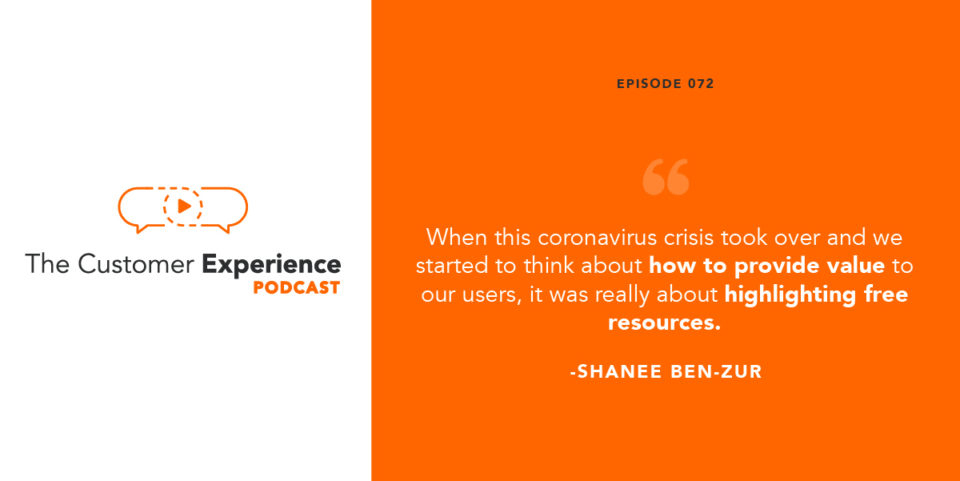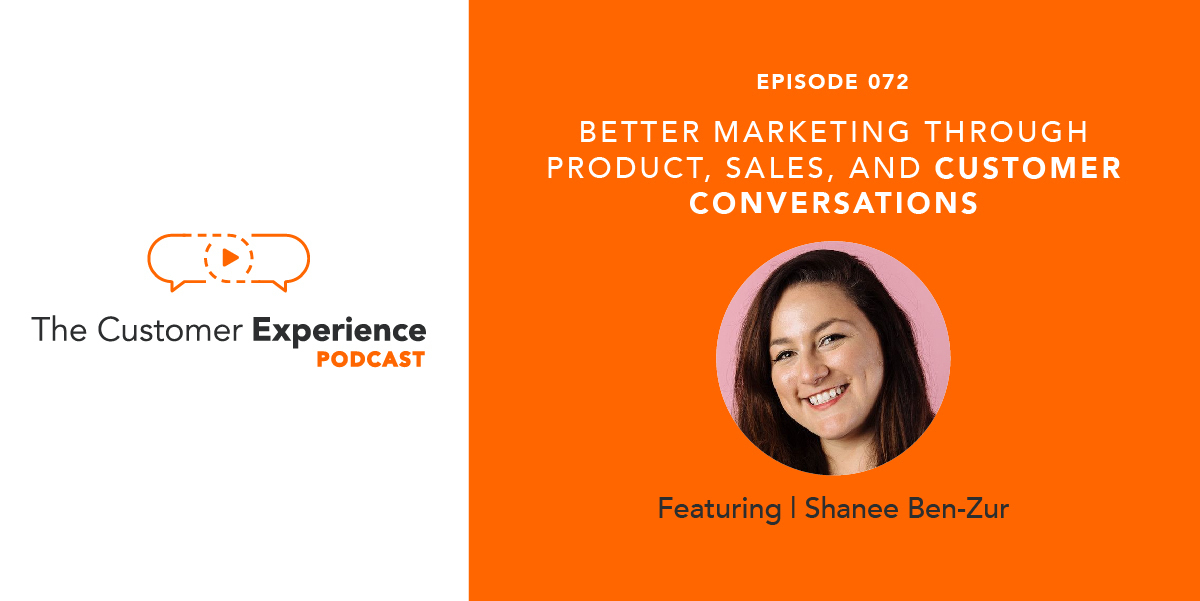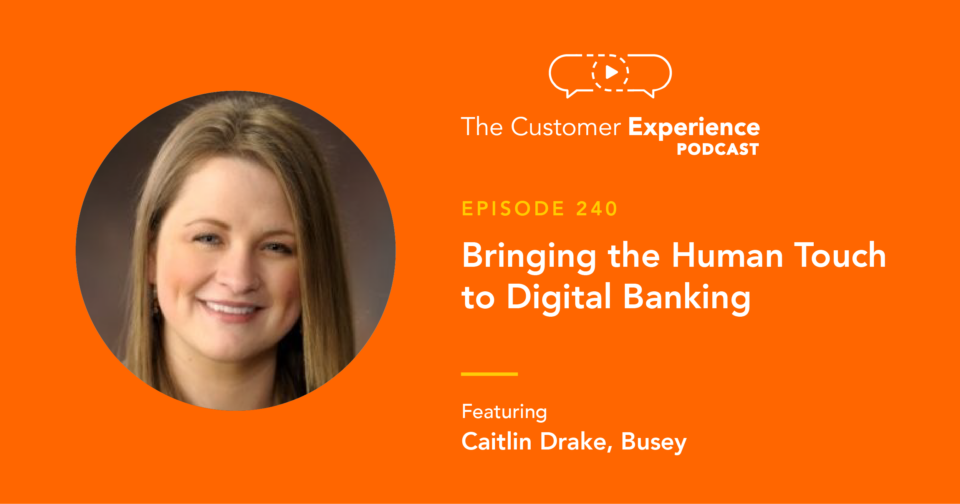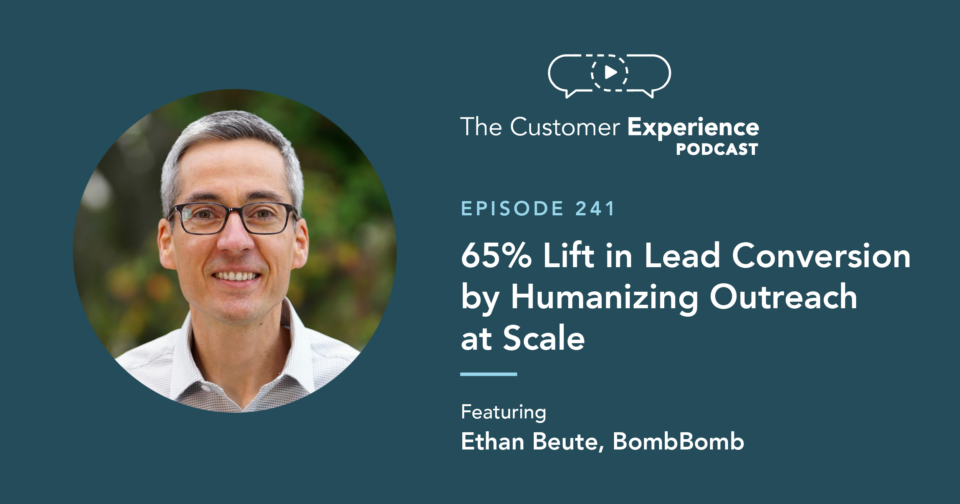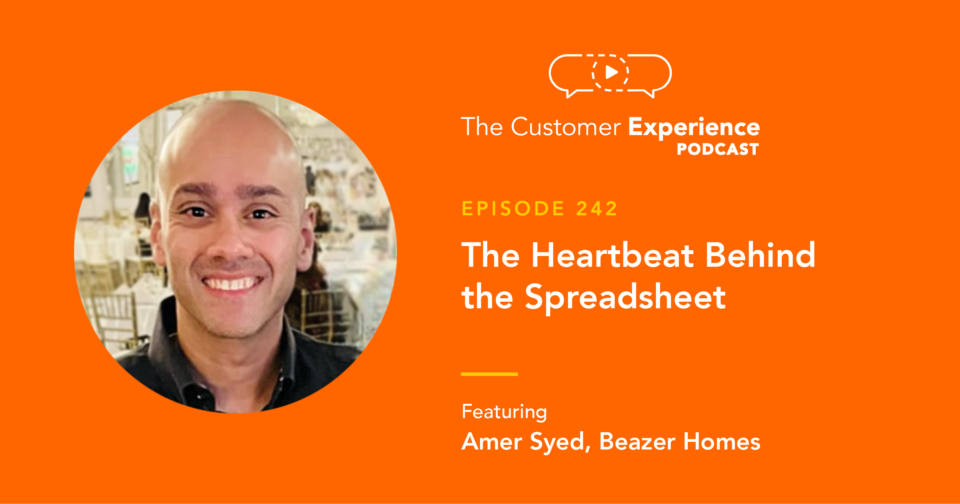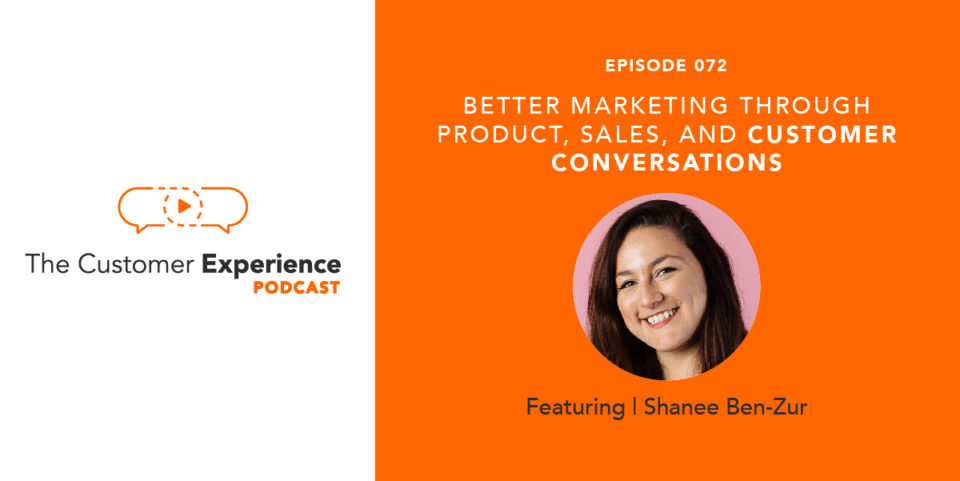
Apple Podcasts | Google Podcasts | Stitcher | Spotify
Data is great. But it doesn’t always paint a full picture of your business.
Want to develop more impactful insights? Start by having more customer conversations. Actual conversations. More often.
Listen to what they have to say. Find out their needs and wants. And use this feedback to improve your product, align with sales, and elevate your customer experience.
Because now more than ever, the experience matters. If you’re not empathetic to what customers are going through, you may not just lose a customer, you may create an enemy.
On this episode of The Customer Experience Podcast Shanee Ben-Zur, shares her knowledge on getting a thorough analysis of customers – by way of growth hacking, data analytics, and account-based information. And she explains the role alignment across teams plays in that.
Shanee is the Head of Marketing, Media, and Growth at Crunchbase. She has done PR, social media, content marketing, influencer marketing, lifecycle marketing, and demand gen at companies like Dropbox, NVIDIA, and Salesforce.
To be a better marketer, you need to have more conversations. Product conversations. Sales conversations. And customer conversations.
Listen to this podcast conversation for inisghts into …
• What is customer experience – from the customer’s perspective
• Why growth marketing and customer centricity aren’t at odds
• Why talking to customers must be a habit
• How product and marketing can be more symbiotic
• How sales and marketing can be more symbiotic
Better Marketing Through Product, Sales, and Customer Conversations
Hear the entire conversation with Shanee Ben-Zur on prioritizing customer conversations right here:
Want a more traditional podcast experience? Check out The Customer Experience Podcast in …
Please take one minute to subscribe, rate, and review the podcast while you’re there. It’s an easy to do – and extremely helpful to the show.
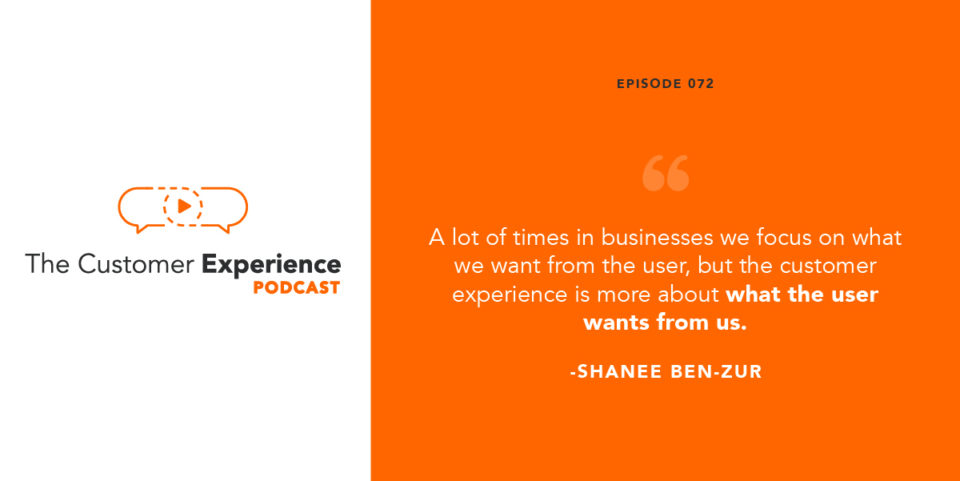
Full Transcript: Better Marketing Through Product, Sales, and Customer Conversations
Ethan Beute:
Your data isn’t always telling the full story. To reveal more meaningful insights you have to do something unscalable, talk to your customers. Our guests today brings ideas to get a better fuller picture of your customer. PR, social media, content marketing, influencer marketing, life cycle marketing, demand gen, you name it, she’s done it at companies like Dropbox, NVIDIA, and Salesforce. She currently serves as head of marketing, media, and growth at Crunchbase. Shanee Ben-Zur, welcome to the customer experience podcast.
Shanee Ben-Zur:
Thank you. Nice to be here.
Ethan Beute:
Yeah, I really appreciate your time and I’m looking forward to the conversation, but before we get going, you’re in San Francisco. What’s the state of affairs with regard to the coronavirus pandemic? How’s it affecting you or your team or your customers? Just kind of set the scene there.
Shanee Ben-Zur:
Well, I’ve been in social isolation for almost a month now. I’m on my fourth week of being in my home and working from home. We made the transition pretty quickly at Crunchbase. Once we saw things accelerating, we made the decision that we were going to go remote and we went from almost a 100% percent in San Francisco headquartered company to a 100% virtual company and I think a lot of other SAS companies in the area have went through the same thing and that in of itself was very stressful.
Shanee Ben-Zur:
That compiled with what’s happening in the world was more stress and then we are a company that sells to a lot of other companies that are kind of at the forefront of dealing with this and they are stressed. Overall I would say it’s kind of an unprecedented amount of stress and actually now more than ever having a focus on the customer experience is important because if we’re not empathetic to what our customers are going through, it’s not just that you won’t make a sale, it’s that you’re going to make an enemy potentially.
Shanee Ben-Zur:
I’ve seen a lot of people on LinkedIn saying, if you send me a note right now and you don’t acknowledge what’s happening, you’re going on the junk pile.
Ethan Beute:
Yeah, it is. Everything is heightened. For you, how big is your team that you manage?
Shanee Ben-Zur:
I have 22 people on the team right now.
Ethan Beute:
And what’s that process like?
Shanee Ben-Zur:
When I first started at Crunchbase about a year and a half ago, we were a team of five. We’ve grown very quickly in that time and we are still adding a couple team members even throughout this. I think for me it’s about having really clear swim lanes for each person on the team. We span pretty much the entire funnel for marketing from brand all the way down to user retention and each of those teams needs to know what their purview is but I also really care about teams working together. We do a lot through Slack, through scrum meetings to try to share out what the key learnings from one pod are with another pod and hopefully identify where there’s some like economies of scale versus just more isolation in a pretty already isolating time.
Ethan Beute:
You already mentioned customer experience once. When I say customer experience, what does that mean to you? What does that term capture or represent?
Shanee Ben-Zur:
I think a lot of times in businesses we focus on what we want from the user. We want them to pay us money, we want them to be more active in the product and I think the customer experience is more about what the user wants from us and more about how they actually feel when they interact with us.
Ethan Beute:
Yeah. That feeling is a really, really key thing that I’m hearing more and thinking a lot more about and so it’s this idea, I love what you offer there just to kind of flip it a little bit and think about how our decisions make them feel about themselves, about us and our products and services, et cetera. I’m familiar with Crunchbase, but for anyone who might not be, who’s Crunchbase, who are your customers and what problem do you solve for them?
Shanee Ben-Zur:
Yeah. Crunchbase as a name has been around for a long time. We actually spun out as a company about five years ago and it is essentially a database with some really strong social tools on top of it that allow you to source for prospects, whether you’re prospecting for a sales lead or an investor or you’re an investor looking for an entrepreneur. People come onto our site because we have information about many, many private companies, typically hard to find information and we give them signals as to whether those companies are healthy, scaling, viable.
Shanee Ben-Zur:
We’ve got lots of categorization that allow people to really kind of drill down into what type of industries they care about and for us, we’re sort of trying to lead this trend around account-based everything. You’ve heard of account-based marketing, there’s account-based selling and our belief is now that there’s more and more privacy laws, the sort of individual contact level, the importance of account-based information is more than ever. That’s really what we try to do, is help people prospect at the account level so that they know how to better use their time and fortunately or unfortunately now that we have so many companies that are dealing with distress around coronavirus, being able to know what companies you should start your search on versus just sort of like spray and pray at the lead level is also really important.
Shanee Ben-Zur:
The people who typically use us, salespeople, number one, they’re looking to make deals. It’s really hard to make deals when people are in financial distress. The investor community also use us and entrepreneurs and those are typically kind of like our three core audiences and then we also have a licensing business where people who are building products that rely on company information can use their data.
Ethan Beute:
Really interesting. I love this idea of account-based everything and you’re obviously well positioned to do it, especially with some proprietary information to help people connect with their accounts more effectively. Have you seen the use go… like in this account-based everything concept how far… obviously the applications in the prospecting and sales process are easy to imagine but beyond that, have you seen any interesting use outside of the sales role?
Shanee Ben-Zur:
Yeah, I mean when we started to kind of develop… we’re working on some really big changes in the product and when we started to develop it, we were looking at what are the types of relationships that happened between two companies and we realized like any person who interfaces with another company could rely on account-based X. An example would be like your BD person is trying to look for a partnership. When you go to a corporate website, you go to www.companyname.com. There isn’t like a website that’s like hello BD people come here.
Shanee Ben-Zur:
I think that’s sort of like a need we’re trying to fill, is any real business to business connection that you need to make whether it’s an exchange for money like a BD deal typically is. There isn’t a resource or a place you can go to and that’s something that we’re trying to explore because it’s just super inefficient for me to type in like job title on a website and get anybody who has that job title but who knows if they’re still in the company I thought they were at. Who knows if their company is doing layoffs right now, they’re very distracted. That’s really like the niche we’re trying to fill, which is, it’s just a lot more efficient. It’s a lot more effective. It’s a better use of everybody’s time.
Ethan Beute:
Really good. You’ve already talked about three specific types of customers. You are a data company with a really cool service layer over it. It sounds like. Let’s talk about getting a fuller picture of the customer. What is really interesting to you about this challenge of blending essentially quantitative and qualitative?
Shanee Ben-Zur:
Yeah, I mean… so I come from kind of like a growth hacking and growth background and I think when people hear that they shutter. I know typically engineering teams try to run away when they see a marketing person from a growth background come into the room and I don’t blame them and I think it’s because at the heart, oftentimes engineers are extremely customer centric and they see that those little tweaks that are growth oriented aren’t always with the customer experience in mind, they’re with the dollar in mind.
Shanee Ben-Zur:
For the most part they’re right, and what you want to look for is somebody who has some type of guardrail metrics where you’re not only prioritizing the dollar over the user experience. An example for us at Crunchbase, we were experimenting with paywalls, with registration walls and paywalls. If you push the paywall to the top, Crunchbase is typically been a very strong freemium brand. If we wanted to push the paywall to the top, yeah there would be some money that comes through initially, but the customer experience would be so bad and so different from what people expect that we would likely turn a lot of our core user base away.
Shanee Ben-Zur:
Even though we did some tests, we ended up removing any hard paywalls from the website and right now we only have some like soft wall reminders and we’re even exploring what the user experience has been as a result of those.
Ethan Beute:
Interesting. In experiments like that, how do you kind of organize people around the opportunity or the problem or the challenge? Is it just like a regular part of your… some part of your team’s workflow or like how does that work come about? I love this idea of testing various types of walls.
Shanee Ben-Zur:
When we first did it in the very, very early days, it was kind of like, well, we never had trial so let’s roll out trial and we never did this, let’s roll out this. As we became more sophisticated, and this is really kudos to the engineering and product team, we rolled out an A/B testing platform, we use split and that allows us to make really educated decisions versus like, well it looks like all the numbers are better and not really know if there’s like cannibalization happening.
Shanee Ben-Zur:
That’s one thing, is having an A/B testing platform is really helpful but beyond that, I think what we realized in terms of galvanizing the company behind an idea was first principles. We spent some time coming up with what our first principles would be, things like actually living our mission. Our mission is to democratize access to opportunities. We really think that if more people can do the thing they want to do, everybody benefits. Like is this wall democratizing access or is it not democratizing access? That’s one question we ask ourselves.
Shanee Ben-Zur:
We look at things like the signals that we have that customers are getting value. One of the things we want to do is actually deliver something valuable to the user and not just ask for something from them and we did this like very… I wouldn’t say it was a 100% scientific, but we took the first principles and for each of the scenarios of walls we were exploring, we did like a plus one if it helped towards the first principle, a minus one if it took away from the principal and a zero. We vetted the opportunities based on the A/B test initially using that score.
Shanee Ben-Zur:
There were some obvious very negative ones and so we dropped those out and then the ones that were sort of in the neutral to positive, then we started to make more subjective decisions with the help of the people who were part of the working group.
Ethan Beute:
Excellent. I really love that approach and when does the customer get involved? When do we do essentially the unscalable, when do we pick up the phone or shoot out an email or set up a Zoom call or whatever? When do you go directly to customers to inform decisions?
Shanee Ben-Zur:
For us, and again, I think this is a really strong vote of confidence behind the way our product team is organized. We are never not talking to customers. Before we even begin building a new feature, we’re interviewing customers. We really wanted to figure out how we can build a better product for the sales use case, so we’ve been spending a lot of time interviewing salespeople in many different industries and that’s to help us understand where would we even start and then once we launch a feature and it gets out of…. when we’re A/B testing we might do some like light interviews here and there, but then once it gets out of A/B testing and it goes to a 100% percent, then we’re sort of leaning on our CX team to do a little bit hands on talking to customers, and on the marketing side, we’re monitoring social everyday for any proactive feedback that people are giving.
Shanee Ben-Zur:
We use Delighted, so we’re seeing what are people actually submitting in their Delighted scores. At all times we’re looking at what are our customers saying and if we ever see a trend or if we see an uptick in a specific conversation, that triggers another conversation either within the product team, at the executive level. It just allows us to constantly be with our ear to the ground on what customers are feeling about the product but I think one of the most important ones is knowing that we’re building for what they want versus building for what we want. Again, for me, that customer experience definition is what are their wants, needs, desires, what are they dealing within their lives versus just our financial need?
Ethan Beute:
Yeah. You mentioned several sources of customer feedback. How do you all organize around it? I mean, does someone just like push the conversation button or the alarm button if something’s getting really hot or do you have a designed like cross functional meeting around it? I mean, like for example, at BombBomb we’ve had a voice of the customer meeting. It’s been in various iterations driven by different motivations at different times and different teams have been represented differently over the years so it’s like… it’s something that’s just top of mind for me. How do you all… With the various sources of input you talked about, how do you organize around that information?
Shanee Ben-Zur:
I mean, to be honest, I think we have a lot of room for improvement. I don’t think we figured it out yet. We haven’t cracked the nut on it. It does feel like what we will… we’ll typically get the signal of like, this metric seems out of whack, but I don’t know why and then we’ll go in and investigate a little bit more deeply. There are some reports that come out on a regular basis. The UX researchers, they share reports on the research that they’re doing, that’s a lot of the forward looking research.
Shanee Ben-Zur:
The customer experience team shares kind of weekly and monthly feedback that they’re seeing but what we would benefit from is having something like, with the customer cross functional meeting where we highlight, hey, this is the key theme. It should probably impact this team’s work. Maybe it’s the marketing team, sometimes will run an advertising campaign that might be too unclear what the goal is or will have a content piece that’s out there that maybe is controversial. Like there needs to be a way that those teams can direct the feedback to the team that can actually take action and I think that’s something we’re looking at, but we haven’t quite figured out yet.
Ethan Beute:
Yeah just for… if this is useful to you or to anyone listening. We have delighted and we do some servings through Pendo feeding into one Slack channel that anyone can subscribe to and I find that to be really, really interesting and useful especially when people choose to add comments to the scoring and so anyone can see it anytime. It’s really good. You’ve mentioned your CX team a couple of times and so they’re kind of two camps on this per my dozens of conversations on this on the show.
Ethan Beute:
Some people that’s just like an evolution or a sub team within customer success and for other people it’s this designed additional layer that works across multiple teams. What does CX mean for you from an organizational, structural standpoint?
Shanee Ben-Zur:
Crunchbase has two product lines, kind of. We have a self serve business that’s the free Crunchbase most people know, it’s Crunchbase Pro and then we have a direct sales business that sells an enterprise and kind of a licensing solution. The CS team covers many of the like larger accounts who have custom contracts, they have CS managers, and then on our self serve business, that’s where our CX team sits and they’re kind of doing more of the scaled support.
Shanee Ben-Zur:
That’s really the division of labor between the two teams. They do roll up into one overall customer success director and she’s thinking about how do we create a great experience for our customers throughout whichever product line they’re on and then we do a lot of information sharing between the two. If we’re seeing that there’s an FAQ coming in from our self serve business, we’ll share that information over to our direct sales business and oftentimes, and why I say sort of like customer experience is a non-scalable but very critical thing, oftentimes your salespeople, your CS people, the ones who are on the front lines, they are the canaries in the coal mine and they will bring you something that’s not yet scaled and they’ll say, hey, this is something to look out for.
Shanee Ben-Zur:
Depending on how sensitive your team is to being able to pivot and change, you either take action at that point or you take that information and you start looking for data that backs it up at scale and that’s what’s happening with both our sales team and CS team. I mean, just last week our sales team was telling us, hey, our prospects are telling us that their budgets are getting frozen and then when we go look at the data we see, alright, fewer people are starting trials than they were two weeks before now and it’s a result of that.
Shanee Ben-Zur:
On the demand gen side of marketing, we’re seeing that we’re getting the same level of MQL, but those MQLs aren’t turning into appointments and then when we talk to the sales team, they tell us they’re not even agreeing to get on the phone anymore. Like these are good leads but those companies are dealing with so much in the world. Again, it’s not… if you went to an analytics person, they would say this isn’t statistically significant but I think the business is an art and you are looking for that middle ground between statistical significance and frankly human significance.
Ethan Beute:
Yeah, it’s really good. It’s the art and the science piece of it. Really good in that CS and sales are obviously customer facing. There are a lot of customer conversations there just by the nature of the role and having that come into marketing and other teams, when does marketing go out and directly communicate with customers? Like is that a regular thing or is that on an ad hoc as needed basis? Like in terms of direct customer communication… besides something like social obviously, which is one of the channels you mentioned, when do you get out and talk to customers or your team members rather?
Shanee Ben-Zur:
Yeah. I look at my product marketing team, one of their core goals is to help us deeply understand who the customer is. They sit alongside the UX research team in order to help us get a better understanding of the customer and while the UX research team is asking questions that relate to how people experience the product, the product marketing team is asking questions about the person.
Shanee Ben-Zur:
An example would be like, we now know that for our perspective customers who are sales development reps, they love reading sports publications. They love ESPN and that’s not a thing that the UX researcher would find out, but it is something that the PMN would find out and for us, it gives us a glimpse into like, okay, well if they love sports, and now because of coronavirus, pretty much every major sport has been canceled, that’s another layer of stress that they’re dealing with.
Shanee Ben-Zur:
It also tells us, can we come up with a sports analogy for something that we’re talking about? It’s this 360 view of who the person is and what their highs are like, what their lows are like, that’s the PMM team and they’re going out and talking to customers constantly. I think there’s also sort of the engagement that we get. When we send out an email to users, most of our emails don’t have no replies. They actually are replyable inboxes and we’re reading that feedback.
Shanee Ben-Zur:
An example was, we have a daily newsletter that we send out that has kind of like the latest funding rounds from companies, the latest acquisitions from companies and we hadn’t decided yet how we were going to change that in light of coronavirus. We were continuing to send it out as normal and we got several emails back where people were saying like, I am glad to see that others are thriving but I am truly in the worst position I have been in my entire career and seeing this newsletter makes me feel bad.
Shanee Ben-Zur:
For us it was like, okay, we were working on some other things, we had prioritized some other things around coronavirus but then we shifted our priority to making sure that we had some kind of acknowledgement in that newsletter of like, if you need resources, these resource is available to you. This newsletter will continue because we think that knowing what companies are still thriving is a positive signal for anybody who’s trying to do business still.
Ethan Beute:
That was such a good example and I think it’s so important mostly because I did it for years and I learned so much doing it, is being… I was the direct reply, like is the only marketing person for several years. Every email, whether it was an offer or a newsletter, a webinar invite, whatever, came from my personal email address which meant that I had, and I felt like that gave me as a marketer just a really good feel and I love that example of what you offer and how you can take something and just… a little tweak makes it more appropriate for the situation because you care about how customers feel.
Ethan Beute:
This is kind of a callback to earlier in the conversation, but it’s something I was interested in, is… your first principles, are they stated? Are they documented? How many are there and is scalability, like does Crunchbase in your team have a position on some things that just are not appropriate to even work on scaling?
Shanee Ben-Zur:
Yeah. I think at this point our first principles are decided almost in the kind of like, not initiative level that’s too narrow but sort of overall project area will have first principles. There are a few things that are unchanging, like that idea of are we giving more value than we’re asking from the customers? Are we living our mission? Those are things that kind of are persistent through everything, but then there are some that might be just specific to that particular kind of area of work.
Shanee Ben-Zur:
We typically will publish those… We use like marketing request docs or product request docs and those outline who the decision makers are, who the input people are and then also what the first principles are and what the hypothesis is. Typically when you’re one of the more senior reviewers, what you’re looking for is what’s the potential impact for scale and you’re weighing that against what are all the other ideas I’ve seen come across my desk.
Shanee Ben-Zur:
That question of how do you prioritize one thing over another? That is really what I spend most of my time with my team talking about, is like this is a great idea. Is this the idea to execute now or is there a different idea that you have in the hopper that would have bigger potential impact? And we kind of triangulate between difficulty, likelihood of success and potential impact and using that triangulation we’ll come up with what are the initiatives we prioritize and we use the OKR system here.
Ethan Beute:
Nice. Is that monthly, quarterly?
Shanee Ben-Zur:
The OKRs are quarterly goals and then within each team we use the sprint system when we use a one week sprint and with these request docs, the projects can last through multiple sprints, but they’re essentially the tactics that will help us achieve the key results we’ve outlined in our OKR.
Ethan Beute:
Really good. You have what I feel like is a very large role. Can you just describe the scope of your role and specifically any philosophy that guides you? You shared some of it already and then maybe let’s transition from there into how you interface with other teams. You’ve already talked a little bit about that, but the goal of the show is to talk a little bit of alignment and it seems like you have a lot to offer there. Start with maybe again the scope of your role.
Shanee Ben-Zur:
Yes. I have several commas in my title, but what they really turn into is, my team runs brand, product marketing, digital marketing, coms, ops. I think that’s all of it. It’s essentially top of funnel, mid funnel consideration and then customer acquisition, demand generation and customer attention. It’s really all parts of engaging with customers from before they’ve ever heard from us to being a multi-year customer. For me, my philosophy with the whole team is, one thing is if you can’t measure it, should you be doing it? Ask yourself that question.
Shanee Ben-Zur:
The other is we don’t do initiatives. We do experiments. I think traditionally marketing is seen as a thing that does big flashy stuff and is measured on the number of stuffs they do and I don’t want that to be what our team is about. It’s more around, we have a hypothesis of what a particular project could do. We test whether it can actually do that and then we scale it to many users, and by following that kind of ethos, we’re able to ensure that everything we do provides value to the company and to the customer.
Shanee Ben-Zur:
In terms of the partnerships, we work really closely with sales. We have a demand gen team that is driving leads for sales. We’re also beginning to partner with our CSM team to see if we can use some of the automation that marketing uses on the self serve side to support how they manage accounts on the CSM side. We partnered very closely with the product and engineering teams because we’re trying to help them figure out how do we bring to market the new features that they’re building and how do we bring back some of that with the customer to them to inform what the product roadmap should be and then the CX team.
Shanee Ben-Zur:
I would say social is sort of a shared surface between us and CX. Because we are very closely aligned with product, we can also give CX a heads up, hey this new feature is coming out. We think it might raise some questions, can you help us kind of bulk up what is happening on the knowledge base with information to proactively tell them. In a lot of ways marketing is kind of like a connective tissue between multiple teams. I think there’s lots of points of connective tissue but for us we are one part service organization supporting those teams and one part strategy organization helping them think about how marketing should be supporting.
Ethan Beute:
So smart. I love your approach. I want to know the answer to the question, if you can’t measure it, should you be doing it? It’s just like kind of hearkens back to the kind of the art and the science pieces like, can you think of something that you green-lighted or supported even though it couldn’t be measured?
Shanee Ben-Zur:
Yeah, I mean I think this is where teams can get frustrated with leaders because what they want is consistency and reliability and sometimes you just have to break the rules. I think one thing that we’ve really been trying to drill into the team is that our primary target audience right now is the sales person but when this kind of coronavirus crisis took over and we started think about how can we provide value to our users and it was really around highlighting free resources, we started looking for resources that also supported the other personas that are our typical uses of Crunchbase and I think people were sort of like, wait, but you told us we have to focus just on sales. Why are we doing this?
Shanee Ben-Zur:
For me it was like, look, these are members of our community. These are members of the ecosystem. The purpose of this initiative is just to create a supportive environment for these people who are truly in distress. This is separate from our kind of more commercially prioritized gains. Is it confusing? Yes. I would be confused if I was on my team and my boss said, “Wait, but now you want me to focus on everybody.” But this is one of those exceptions where it’s like these are exceptional times and I think we can differentiate our brand if we show that we actually care about what people are going through and that we really do want to be helpful to them.
Shanee Ben-Zur:
I hope that my team accepts that as a proper reason why we veered from our very strict course.
Ethan Beute:
Yeah. It is very challenging. We decided something that we could do uniquely to help was to offer BombBomb absolutely free to educators at all levels from like pre-K through PhD. Within like 36 hours of green-lighting the project we had it live, it’s been live for a couple of weeks now and we’ve got like 3,500 to 4,000, I don’t know where we are exactly right now. Teachers from all over the place using it in order to stay face to face with their peers and with students and with parents and we’re getting really good positive feedback on it but to kind of what you offered there, it was like we knew it was the right thing. It’s not commercial, it’s generating no revenue. In fact it’s costing us money to A, host all the videos. B, we’re trying to have them self serve but of course they’re still in our communication channels needing some help and guidance, which is reasonable.
Ethan Beute:
And then the tension of we still do have to address so much of the rest of our marketing and messaging pieces at the same time. How do you balance all of this? Where does it fall on the priority and how long does it stay a priority? I mean, it was like all hands for two days basically to get it live and so really interesting and challenging, but it’s this… obviously as you’re experiencing leadership in a really, really unique time to your point, sometimes you have to either break the rules or just throw them out or just not look at them or something.
Shanee Ben-Zur:
Yeah. It is. I never expected that I would be going through this and leading through this and it’s… at times it’s overwhelming because I care. I spend a lot of time caring, right? Like I care deeply about my team, I care deeply about the company, I care deeply about the customers, I care deeply about my own family and my own community and all of that care is sort of overwhelming and it makes it difficult to make the logical decisions that I’ve typically known for but I think like if there ever was a time to not be logical, this is it.
Ethan Beute:
Sure. Because a lot of it doesn’t make any sense. I’m going to ask you a couple of questions that I really enjoy asking, especially with someone like you who’s working. The way that you view your marketing team and what its purpose is and the way it connects to the rest of the organization, the connective tissue as you said. What do you wish more product people or developers knew or understood about marketing or the marketing function?
Shanee Ben-Zur:
You’re setting me up to start a fire?
Ethan Beute:
No I’m not. I have gotten that reaction before, but I still like the question. I always find like you have… anyway, I won’t tee it up anymore. Do you have anything to offer there?
Shanee Ben-Zur:
I think it’s a very symbiotic relationship. I would say that the tightest symbiotic relationships again, are the marketing product, marketing sales and marketing CS and the marketing product symbiosis is we can give insight into what people want on an ongoing basis. We can also give insight into what people will consume at a higher rate. I think it was Apple who always talked about like, people don’t know what they want and they’re building these products that we’ve never asked for.
Shanee Ben-Zur:
If you just ask the question, what do you want? You’re going to end up with a product that’s a direct competitor of something they already know. We can help you with that sort of like what they don’t even know they want, but what they need. That’s part of the symbiotic relationship, is sort of informing the product roadmap and the other is we can also help understand when and how to bring those features to market.
Shanee Ben-Zur:
Yes, you could just keep releasing things on an ongoing basis and just let it be a steady drip of features to users but there’s something really powerful about kind of putting things into a bucket so we might be able to help you understand, hey, all of these features, these things are collaboration features and I think in this time of isolation, collaboration is really important so why don’t we change the timing of the releases of these things and put it under this kind of messaging banner.
Shanee Ben-Zur:
That’s not something product has to think about but that is something that marketing thinks about and can help sort of inform and that’s around us like go to market strategy, go to market positioning, go to market messaging. That’s really where we can be useful. Where I have seen the relationship not be symbiotic, where I’ve seen it sort of be less effective is when one team or the other is the sole leader. It really does have to be side by side. If marketing is just informing product, they might be over promising what they can actually deliver.
Shanee Ben-Zur:
If product is the only one leading and marketing is involved, they might just be doing things into an echo chamber or like a tree falls in a forest and no one hears it kind of thing but when they work together, that’s when you build products that actually have product market fit and that customers really want and need and understand.
Ethan Beute:
Yeah. I like the way you took that and I like the symbiosis language. Can you talk about the same thing with regard to sales and marketing?
Shanee Ben-Zur:
Yeah, I mean, it’s so interesting because I’ve worked in organizations where those relationships were very unhealthy and now in Crunchbase I think it’s the first time where I’ve seen them be extremely healthy and I don’t know if it’s a factor of the company being so small that we actually have personal relationships. Like I have a very close relationship with the head of product, with the head of sales and I don’t know if that’s the reason, but whatever it is, I would fight somebody if they tried to get in the way of the efficacy of that relationship.
Shanee Ben-Zur:
The symbiosis between marketing and sales is, on the sales side what they’re offering is that frontline canary in the coal mine. What are people actually saying? In a lot of ways they’re like the UX researcher for us and on our side we are letting them know, hey, here’s how we can get to scale. Like you may be finding that only people with this very specific job title are the ones who convert but if we only focused on that before it gets to you, you won’t have any leads to work so we’re giving them feedback around like what’s the macro trends that are happening out in the world and bringing that down to them.
Shanee Ben-Zur:
We’re also able to say, hey, we’ve been doing these like top of funnel content marketing things, either ebooks or webinars and this is what’s resonating with them and then feeding that back to the sales team as like topical information that they could be bringing up. It really is, they’re telling us what’s working on their side. We’re telling them what’s working on our side and again, we’re triangulating what’s actually the need of the user and the customer and I think the other part of the symbiotic relationship is because we have a tight relationship with product, we can help translate what it is that salespeople are seeing customers or prospects ask for on the front line into a reasonable request for the product team because, typically what you see happen is you’ll have one sales interaction where a prospect will say, “Oh, I want this feature.” And then that sales person will go to product and be like, “This is what we need.” And product goes like, “I don’t even understand the words that you’re saying.” They can be the middle people for that and help translate.
Ethan Beute:
Yeah. That is a really good marketing function relative to sales and product. I love that call out. I think you’re absolutely right. I do think the personal relationships make a big, big difference. There’s just so much that comes out of a healthy relationship with another human that just can’t be faked or replicated any other way than through knowing, understanding, and appreciating the other person as the foundation for being successful together.
Shanee Ben-Zur:
The emotional safety to be vulnerable between those teams is also critical. It really is, you have to win together but you also have to fail together. If there starts to be situations, especially now in high times where leads are going to be harder to come by, if you have a situation where there starts to be finger pointing and that trust gets lost, that’s also when I think that symbiotic relationship becomes unhealthy. Finding a way to build lots of visibility and transparency between the teams such that anybody anywhere can make a suggestion, no commitment whether it will happen, but a feeling of like, hey, I can throw this idea over to you. I know that you’ll take it in the spirit in which it was intended. That I think is also a really important part of what makes a symbiotic relationship work?
Ethan Beute:
It’s fantastic. I think this idea of winning and losing together really prevents one of the worst things that can happen from a relationship standpoint or a functional standpoint is blaming, looking for blame and these kinds of… like some of that negative behavior that happens when you’re not losing together and being honest about it with each other and again, some of the keywords you offered there, including transparency so that everyone understands exactly what’s going on.
Ethan Beute:
I have so enjoyed this conversation. You have a lot going on. I’m going to give you the rest of your day back but before I do, I want to let listeners know that if you enjoyed this conversation, you might like episode 34 with Michael Redbord, formerly of HubSpot, 4 Things Every Customer Wishes You Understood About Them and episode 63, a more recent one with David Meerman Scott, Creating Fans Through Human Connection.
Ethan Beute:
Shanee, before I let you go, I would love to know someone who you appreciate for the positive impact that she or he has had on your life or your career.
Shanee Ben-Zur:
Kady Srinivasan was my former manager at Dropbox. I’m a really direct person. Sometimes that is good, sometimes that is bad and for most of my career I was told to just be softer, to be less intimidating and I think that was really hard for me kind of growing up in my career because I always felt like who I am was not right. Who I am was not good for the workplace and Caty was the first person who said they’re wrong. Who you are is what makes you magical and lean into it. Flex to people. You’re not trying to hurt other people, but lean into what makes you strong. Don’t be afraid and honestly, it was like an unlocked gate where I just felt like I was able to achieve a million times more than I ever had before because I wasn’t wasting as much time thinking about how to be smaller, how to be less.
Shanee Ben-Zur:
Huge thank you to Caty. I think she really changed my life in a lot of ways. Starting with my job.
Ethan Beute:
The phrase I was thinking as you were sharing that was like life changing. I mean, like this opportunity to give yourself permission just to do what you do as you do it is just so wonderful. A great call out there. How about a company that you really respect or appreciate for the way that they deliver for you as a customer?
Shanee Ben-Zur:
I’ve been noodling on this idea, and I think I’m going to call it a really small business. I’m a member of a small wine club up in Napa and originally I had my delivery address as my husband’s office because you have to sign for alcohol in California and I got the email notification that it was being shipped to the office and we were under lockdown. I immediately shot them an email. I’m just like shooting emails to random email addresses at the winery and I’m like, “Hey, is there any way we could change this?”
Shanee Ben-Zur:
In less than 24 hours they said, no problem. They had it redirected, which I can only imagine how difficult that was and they were just like so happy to do it for me because they understood what I was going through being literally locked indoors and I think it just showed A, I can only imagine how stressful it is for them. They’re a very small business. I’m sure that as people lose more of their income, luxuries like wine are going to be things that they cut and yet they took the time to express loyalty towards an existing customer and go above and beyond what my expectations were of them.
Shanee Ben-Zur:
I’m seeing actually that level of loyalty and customer focus happen from a lot of really small businesses. I have this hypothesis and hope that there’s going to be a resurgence in the sort of like cottage industry and maybe a beginning of a shift away from the monolithic brands because of this level of customer focus.
Ethan Beute:
Yeah. It’s really interesting to think about. I love the example by the way. I think they’re going to be okay and I say that only because here in Colorado when we got our stay… they call, our stay at home. When we got our stay at home order they accepted of course groceries and some other things like that, but they also accepted the liquor stores and beer stores and wine stores and same thing happened to my buddy Steve out in Pennsylvania.
Ethan Beute:
First they closed the beer stores and then they opened them back up like a week later. Hopefully that business will be okay but what you offer is really interesting, especially as people’s careers are disrupted and they need to maybe reinvent whenever we’re on kind of the better side of the situation that we’re all in right now and so I have the same hope. It’s an exciting thought and I do think kind of the essence of what you offer there too is this idea that these are the times we are going to remember how the brands and companies and products and services made us feel, so the ones that make us feel cared for, long-term loyalty.
Shanee Ben-Zur:
Yeah. Yes. I think it’s all about empathy right now.
Ethan Beute:
It is. I’m seeing a lot of that on LinkedIn and it’s nice. I hope that a lot of these things that emerge including like… we’re recording this on a Monday, so I’m home, but I feel like now a couple of weeks into it and we’re not as far along as you are. That I feel obviously closer to my family because I see them a lot more, my wife and my son and closer to my neighborhood because I’m walking and running a lot more and at different times of the day I’m more familiar with the way the light moves through my own home during the day.
Ethan Beute:
I’m hoping that some of these small things and these nice things stay with us when some new normalcy returns.
Shanee Ben-Zur:
I agree. I think there’s a lot of really interesting new changes that are happening around us and the people and the companies that are agile and able to adapt to this world, I think we’re going to find so many cool new things happen. I’m also a little optimistic about this. Like obviously I hope that we find a way to stymie the spread of this disease because like the human impact is horrible, but this is also where like interesting innovation is going to happen. People are going to be more connected to their family. People are going to be more connected to their communities and that’s a thing, at least in the U.S. we’ve needed for a while. It’s weird that isolation is what’s driving connection, but it is.
Ethan Beute:
Yeah, I feel like all the social networks are a bit more lively than before. Of course, Facebook in particular is still as kind of antagonistic as ever. It’s weird how something like this can be so political but I do feel like more people are there looking for that kind of connection and of course at BombBomb because we make it easy to record and send videos and not just do Zoom calls like this. Zoom of course is probably through the roof crazy busy right now but so are we. It’s really interesting. On the one side we have customers who are struggling and they’re reviewing all of their expenses and trying to figure out what they’re going to do nut on the other side we have… I guess generally speaking, lead flow that we haven’t seen in some time. It’s all just so interesting.
Ethan Beute:
I am going to let you get back to your day. I appreciate you so much. I appreciate your time and I know if someone is listening to us right now, they appreciate your time and your insights as well. If anyone wants to follow up and connect with you or with Crunchbase, where would you send people?
Shanee Ben-Zur:
With Crunchbase just www.crunchbase.com. With me, I’m on LinkedIn Shanee Ben-Zur. There aren’t a lot of us, so you’ll probably find me and also on Twitter @ShaneeBenZur.
Ethan Beute:
Awesome. Thank you again so much and I hope you have a great rest of your day and I hope you are unlocked soon.
Shanee Ben-Zur:
Thank you. You too.
Video Highlights: Better Marketing Through Product, Sales, and Customer Conversations
Check out the top five video highlights from the discussion with Shanee below…
1. What is CX from the Customer Perspective
2. Growth Marketing vs Customer Centricity
3. Always Be In Customer Conversations
4. The Symbiosis of Product and Marketing
5. The Symbiosis of Sales and Marketing
More from Shanee:
Other CX Conversations You’ll Enjoy:
- “Uniting Customers and Brands Through Experiential Marketing” with Ruthie Schulder (Cofounder and CEO, The Participation Agency)
- “4 Things Every Customer Wishes You Understood About Them” with Michael Redbord (former General Manager of Service Hub, HubSpot)
- “‘The Holy Grail’ of Connecting with Your Customers” with Ann Handley (Chief Content Officer, MarketingProfs)
Please Subscribe to and Rate The Customer Experience Podcast:
